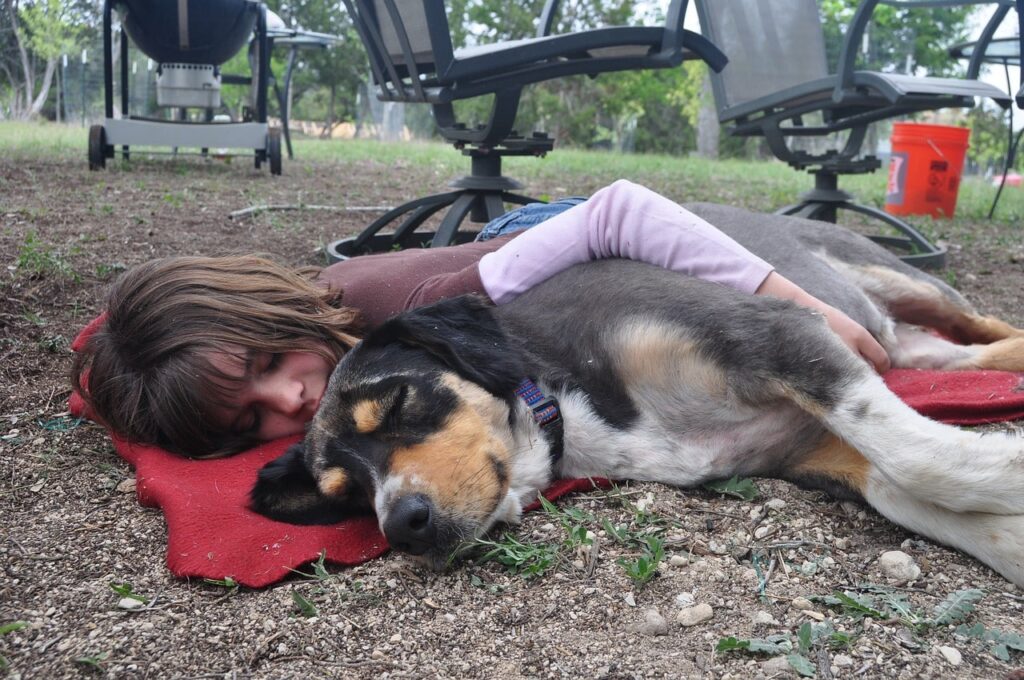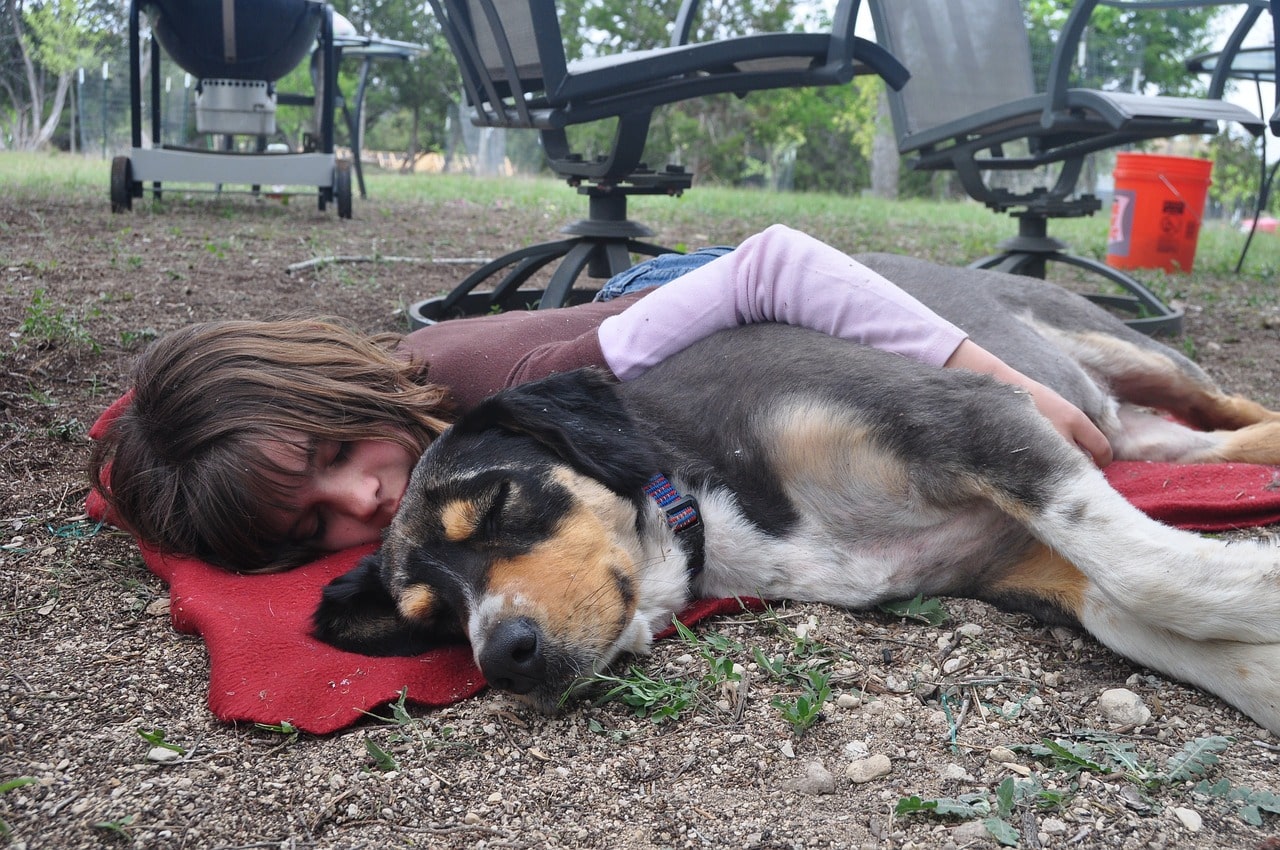The age-old debate of whether to let your dog sleep with you is a decision many pet owners grapple with.
On one hand, it can create a sense of closeness and comfort; on the other, potential challenges may arise.
In this guide, we’ll explore the pros and cons and provide 13 key tips (Should I Let My Dog Sleep with Me?) to help you make an informed decision and, if you choose to share your bed, ensure a harmonious and restful night for both you and your furry friend.
Table of Contents
Should I Let My Dog Sleep with Me? – To Share or Not to Share

1] Health Considerations
Taking a proactive approach to your dog’s well-being involves a thorough assessment of potential health considerations impacting their sleep.
Regular veterinary check-ups play a crucial role in identifying and addressing allergies and zoonotic diseases.
By staying attuned to their health needs, you’re ensuring that your beloved companion can enjoy restful sleep and wake up refreshed.
Tip: “Ensure that sharing a bed does not expose you to zoonotic diseases. Prioritize health considerations for both you and your dog.”
2] Behavioral Factors
Delving into the world of your dog’s unique sleep habits is an adventure in understanding and companionship.
Just like humans, dogs exhibit individual preferences in how they choose to snooze.
Quote: “In the shared dreams of night, understanding your dog’s sleep habits becomes the melody of restful coexistence.”
From curling up in a cozy nook to stretching out luxuriously, observing these behaviors allows you to tailor their sleep environment, ensuring it aligns perfectly with their distinctive inclinations.
3] Size and Space
Crafting the ideal sleep arrangement for your dog involves thoughtful consideration of their size and space preferences.
Smaller breeds may find solace in enclosed spaces, while larger companions might appreciate more expansive sleeping quarters.
Striking the right balance ensures that your dog’s sleep environment is a snug fit, promoting optimal comfort.
• Consider your dog's size and preferences for a comfy sleep space • Smaller breeds may like enclosed spots, larger dogs prefer roominess • Find the right balance for snug fit and optimal comfort
4] Temperature Preferences
Just like us, dogs have specific temperature preferences that impact their sleep quality.
Tuning in to how your dog responds to different temperatures allows you to create a sleep environment that caters to their comfort.
Whether it’s providing cozy blankets for chilly nights or ensuring proper ventilation in warmer weather, you’re tailoring their surroundings to perfection.
5] Sleeping Patterns
Overview: “Align your sleep schedules with your dog’s crepuscular nature for a more harmonious co-sleeping experience.”
Syncing your dog’s sleep schedule with their natural circadian rhythms lays the foundation for a well-regulated and balanced life.
Dogs thrive on routine, and establishing consistent sleep and wake times helps regulate their internal clock.
This commitment to a predictable schedule promotes not only restful sleep for your furry friend but also a harmonious daily rhythm.
6] Separation Anxiety
Recognizing and addressing potential separation anxiety is a key aspect of fostering a tranquil sleep experience for your dog.
Gradual desensitization to alone time, the comfort of familiar scents, and the engagement provided by interactive toys contribute to alleviating anxiety.
Tip: “Allowing your dog to sleep with you may provide comfort and reduce anxiety, fostering a deeper bond.”
By addressing their emotional needs, you’re creating a sleep environment rooted in security.
7] Training Consistency
Striking the right balance between enforcing rules and nurturing your bond with your dog is an art.
Consistent training practices build trust and reinforce positive sleep behaviors.
Establishing a bedtime routine that incorporates both structure and bonding elements fosters an environment where your dog feels secure and cherished.
In the disciplined dance of co-sleeping, training and bonding create a symphony of shared dreams.
8] Bedding Protection
Investing in bedding protection is a practical measure to mitigate potential messes.
Opt for durable, washable materials that can withstand the occasional accident or shedding fur.
By prioritizing your dog’s comfort while maintaining a clean sleeping area, you’re ensuring that their sleep space remains hygienic and inviting.
9] Allergy Considerations
Addressing allergy considerations is a proactive step toward promoting a healthy sleep environment.
Regular grooming, the use of hypoallergenic bedding, and a commitment to maintaining a clean living space all contribute to reducing allergens.
This approach not only supports your dog’s health but also ensures that their sleep is uninterrupted by allergic reactions.
• Regular grooming, hypoallergenic bedding, and a clean living space reduce allergens • Supports your dog's health and ensures uninterrupted sleep • Take steps to minimize potential allergic reactions.
10] Human Sleep Quality
Acknowledging the impact of your dog’s sleep arrangements on your own rest is vital for a harmonious co-sleeping experience.
Creating shared sleep spaces that prioritize comfort for both you and your furry companion ensures a restful night’s sleep for everyone in the household.
Striking this balance contributes to a positive sleep environment.
11] Personal Space
Overview: “Establish personal space boundaries for a comfortable night’s sleep. Teach your dog to respect your sleeping area and avoid disruptive behaviors.”
Respecting personal space for both you and your dog is a cornerstone of peaceful coexistence.
While cuddling is a cherished aspect of your relationship, establishing clear boundaries ensures a comfortable and respectful sleep environment.
Designating specific sleep areas strikes the perfect balance between togetherness and personal space.
12] Age and Health
Adapting sleep arrangements to accommodate changing needs with age and health is a thoughtful approach to your dog’s well-being.
Senior dogs may benefit from orthopedic bedding, while specific health conditions might require adjustments to their sleep environment.
Tip: “Ensure that the sleeping environment meets the changing needs of your dog for a restful night.”
Regular reassessment and modification ensure that your dog’s sleep space evolves in tandem with their individual requirements.
13] Morning Routines
Structuring morning routines to align with your dog’s wake-up times sets a positive tone for the day.
Whether your dog is an early riser or prefers a leisurely morning, accommodating their schedule promotes a relaxed start to the day.
This mindful approach contributes to a sense of well-being that extends throughout the day.
In the morning symphony of shared wakefulness, planning wake-up times orchestrates a sunrise of mutual companionship
Should I Let My Dog Sleep with Me? – FAQs
Can letting my dog sleep with me cause allergies?
Yes, sharing a bed with your dog can trigger allergies. Consult with a healthcare provider to assess potential risks and implement measures to manage allergies.
What if my dog snores loudly during the night?
Excessive snoring can disrupt sleep. Consider addressing the underlying cause, such as potential health issues, and explore solutions to mitigate snoring.
Is co-sleeping suitable for all dog breeds?
Co-sleeping suitability varies among breeds. Consider your dog’s size, temperament, and sleep habits to determine if sharing a bed is suitable for your specific breed.
Can co-sleeping impact my relationship with my dog?
Co-sleeping can strengthen the bond with your dog. Consistent training and establishing boundaries contribute to a positive co-sleeping experience.

Conclusion:
Deciding whether to let your dog sleep with you is a personal choice that depends on various factors, including your lifestyle, sleep preferences, and your dog’s behavior.
The 13 tips (Should I Let My Dog Sleep with Me?) shared in this guide aim to guide you in creating a positive and healthy co-sleeping arrangement.
Whether you opt for a shared bed or a separate sleeping space for your dog, the key is to establish boundaries, foster good sleep hygiene, and ensure that both you and your canine companion enjoy a restful night’s sleep.





